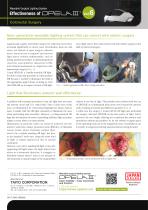 Website:
OPELAIII
Website:
OPELAIII
Group: Taiyo Corporation
Catalog excerpts

Wearable Surgical Lighting System Vol.t Colorectal Surgery Next-generation wearable lighting system that can coexist with robotic surgery Laparoscopic surgery and robotic surgery for colorectal cancer have increased significantly in recent years. Nevertheless, there are still cases, not limited to open surgery, wherein direct visual access is required and external light source remains indispensable, such as during perineal procedure in abdominoperineal resection, anal sphincter dissection in ISR, and coloanal anastomosis in conjunction with laparoscopic surgery (Fig. 1). I used OPELAM, a “mobile-wearable OR light,” for direct visual anal procedure in robot-assisted ISR because I needed to illuminate the field at the appropriate angle I desire. In doing so, I felt that OPELAM, as a compact version of OR light, was a light source that could coexist well with robotic surgery in the field of colorectal surgery. A problem with transanal procedure is that the light does not reach the anterior rectal wall. It is critical that I have a clear view of this area, yet illumination by conventional lighting has always had an issue. I usually shift the OR light constantly to illuminate the anus when performing anal procedure. However, a ceiling-mounted OR light has its limitation in terms of providing sufficient light at proper angles to areas where it is most needed. Illumination of posterior walls can easily be achieved, but the anterior walls have always presented some difficulty. At Shizuoka Cancer Center, where I formerly worked, there used to be a mobile standing OR light, but here at the hospital I work now, using the same kind of light is simply impractical due to spatial constraints. However, even with a standing OR light or any selfsupporting OR light where the light shines from above in a downward direction, it struggles to illuminate exactly where I want to see because of the horizontal or upward angle of the surgical field relative to my line of sight. This problem was resolved with the use of OPELAM as it illuminated deep areas even beyond the anterior walls, resulting in smooth and effortless operation (Fig. 2). A while into the surgery, I turned off the OR light and performed the surgery with just OPELAM as the lone source of light. And it proved to be very bright, allowing me to perform the anterior wall procedures without any problem. As its size neither occupies space in the operating room nor in the equipment room, I would like to use it actively in surgeries involving anal procedures moving forward. OPELAIII®is registered in U.S. Patent and Trademark Office. □RS—KHTis trademark of Taiyo corporation. [Manufacturer] TAIYO CORPORATION 30-9, SHIBA 5 CHOME, MINATO-KU, TOKYO 108-0014 JAPAN TEL +81 -3-5440-6273 FAX +81 -3-5440-2080 Wearable surgical lighting system □pelkht Clear visibility + Easy movement and Comfort [ OPELAl website ] JAPAN BRAND Patents & Designs Registered Check the testimonial video!
Open the catalog to page 1All OPELAIII catalogs and technical brochures
-
OPELA III BROCHURE
2 Pages
-
OPELA III Instruction Manual USA
28 Pages
-
OPELA III Instruction Manual
28 Pages











